“April 25th at last made its appearance . . . . At last the singularly lingering winter of 1842 and 1843 was over. Having conveyed the whole of our effects aboard the steamer, and being supplied with excellent letters, we left St. Louis at 11.30 A.M., with . . . a hundred and one trappers of all descriptions and nearly a dozen different nationalities. . . .”
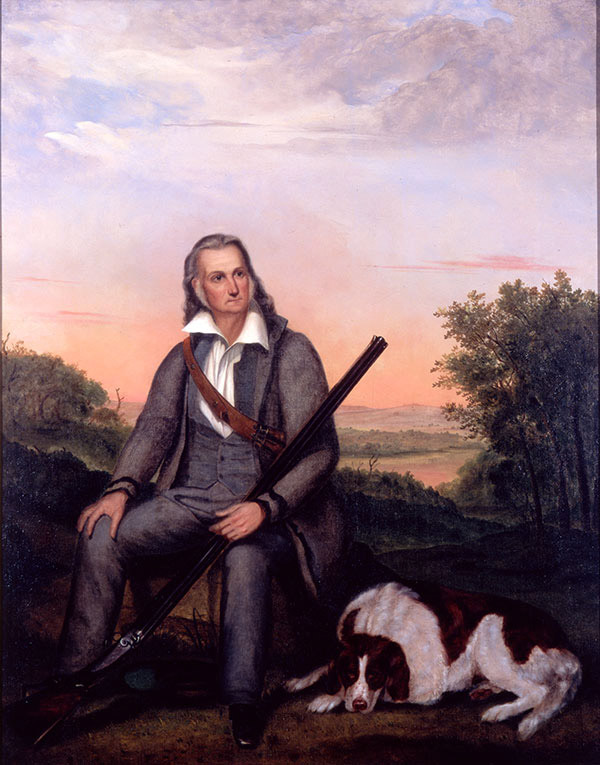
So began John James Audubon’s account (Volume 1 and Volume 2) of his journey up the Missouri River to research the “Quadrupeds of North America.” He had waited more than a month to board the steamboat to proceed up the Missouri River to investigate the birds and animals of the northern Great Plains. We know Audubon as a naturalist who identified and painted many previously unidentified species of North American birds, but on this trip, he was specifically interested in four-footed mammals.
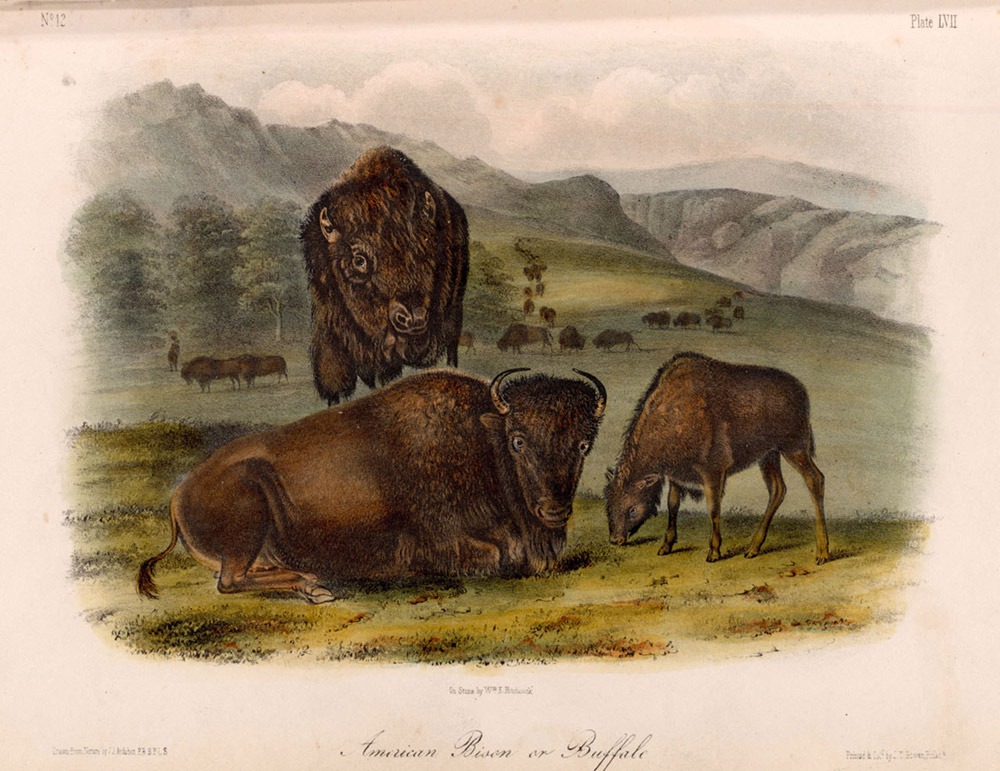
As Audubon traveled by boat up the Missouri River, he listed birds he could see, hear, or shoot from the boat. He began to hear the song of the Western Meadow Lark as he approached the southern border of present-day North Dakota. He noted that the bird’s “songs and single notes were quite different from those of the Eastern States.” He eventually shot a meadowlark and identified it as a distinct species, the Western Meadowlark (Sturnella neglecta). (See Image 2.)
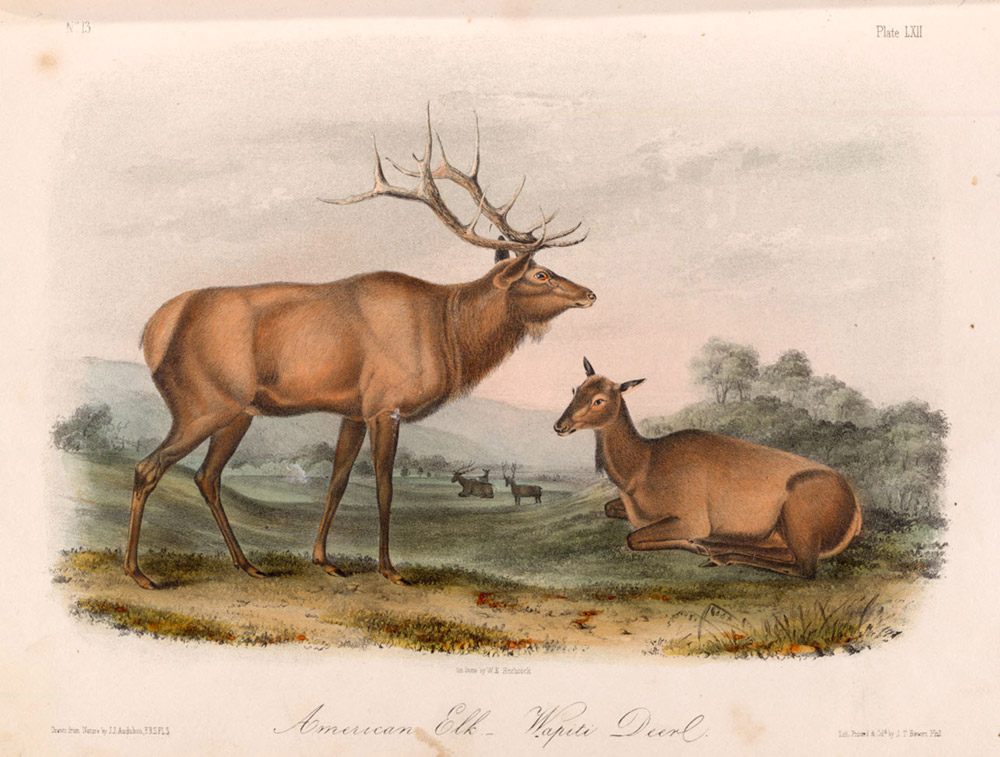
Though Audubon killed birds and other animals so that he could preserve the skin, feathers, and bones for examination, he did not shoot animals that he was not going to eat (he rarely ate meat) or use for scientific purposes. (See Image 3.) He was appalled at the waste of buffalo (bison) carcasses on the plains and foresaw the beginning of the end of the great bison herds. On May 23, 1843, he wrote in his journal:
“. . . these two [hunters] managed to kill four Buffaloes. . . . Only a few pieces from a young bull, and its tongue, were brought on board, most of the men being too lazy, or too far off, to cut out even the tongues of the others; and thus it is that thousands multiplied by thousands of Buffaloes are murdered in senseless play.”
Audubon recorded sightings and shootings of birds daily, but when he had a chance to examine “quadrupeds,” he focused entirely on them. (See Document 3) He measured, photographed, and drew pictures of bison, elk, white-tailed deer, mule deer, big horn sheep, “antelopes,” wolves, prairie dogs, and rabbits among other species. (See Image 4.) His pictures were later reproduced in a book titled The Quadrupeds of North America which was published in 1851.
Document 3. John James Audubon
June 5th [1843], Monday. We have seen Geese and Goslings, Ravens, Blue Herons, Bluebirds, Thrushes, Red-headed Woodpeckers and Red-shafted ditto, Martins, an immense number of Rough-winged Swallows about their holes, and Barn Swallows. We heard Killdeers last evening. Small Crested Flycatchers, Summer Yellow-birds, Maryland Yellow-throats, House Wrens are seen as we pass along our route; while the Spotted Sandpiper accompanies us all along the river. Sparrow Hawks, Turkey Buzzards, Arctic Towhee Buntings, Cat-birds, Mallards, Coots, Gadwalls, King-birds, Yellow-breasted Chats, Red Thrushes, all are noted as we pass. . . . We have seen only one Wolf.
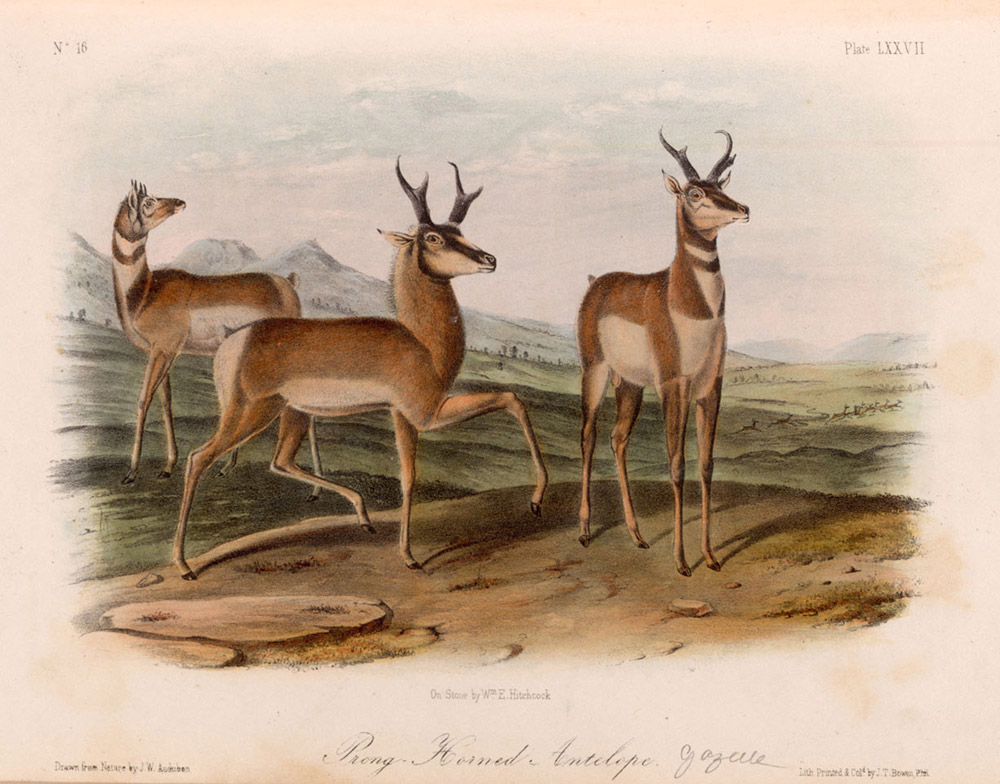
Harris and Bell had their guns, and brought two Arctic Towhee Buntings and a Black-billed Cuckoo. . . The place where we landed showed many signs of Deer, Elk, and Buffaloes. I saw trees where the latter had rubbed their heavy bodies against the bark, till they had completely robbed the tree of its garment. We saw several Red-shafted Woodpeckers, and other birds named before. The Buffalo, when hunted on horseback, does not carry its tail erect, as has been represented in books, but close between the legs; but when you see a Buffalo bull work its tail sideways in a twisted rolling fashion, then take care of him, as it is a sure sign of his intention to rush against his pursuer's horse, which is very dangerous, both to hunter and steed. As we proceeded I saw two fine White-headed Eagles alighting on their nest, where perhaps they had young—and how remarkably late in the season this species does breed here! We also saw a young Sandhill Crane, and on an open prairie four Antelopes [pronghorn] a few hundred yards off. (See Image 5.) Alexis tells me that at this season this is a rare occurrence, as the females are generally in the brushwood now; but in this instance the male and three females were on open prairie.
The country appears to Harris and to myself as if we had outrun the progress of vegetation, as from the boat we observed oaks scarcely in leaflets, whilst two hundred miles below, and indeed at a much less distance, we saw the same timber in nearly full leaf; flowers are also scarce. A single Wolf was seen by some one on deck. Nothing can be possibly keener than the senses of hearing and sight, as well as of smell, in the Antelope. Not one was ever known to jump up close to a hunter; and the very motion of the grasses, as these are wafted by the wind, will keep them awake and on the alert. . . . We have seen not less than three nests of White-headed Eagles this day.
June 7th, Wednesday. We reached Fort Clark and the Mandan Villages at half-past seven this morning. . . We saw some small spots cultivated, where corn, pumpkins, and beans are grown.
June 8, Thursday. . . . At the last wood-cutting place, a young leveret [hare] was was killed by the stroke of a stick. It proved to be the young of Lepus townsendii [L. campestris], large enough to have left the mother, and weighing rather more than a pound. It is a very beautiful specimen. The eyes are very large, and the iris pure amber color. Its hair is tightly, but beautifully curled. . . . Bell will make a fine skin of it to-morrow morning.
Bell fired at a bird, and a large Wolf immediately made its appearance. This is always the case in this country; when you shoot an animal and hide yourself, you may see, in less than half an hour, from ten to thirty of these hungry rascals around the carcass, and have fine fun shooting at them.
June 9th, Friday. We passed the Little Missouri. . . . We saw three Elks swimming across it, and the number of this fine species of Deer [elk] that are about us now is almost inconceivable.
At this moment I heard the report of a gun from the point where the men had been seen, and when we reached the steamboat, we were told that a Buffalo had been killed. From the deck I saw a man swimming round the animal; he got on its side, and floated down the stream with it. The captain sent a parcel of men with a rope; the swimmer fastened this round the neck of the Buffalo, and with his assistance, for he now swam all the way, the poor beast was brought alongside; and as the tackle had been previously fixed, it was hauled up on the fore deck. Sprague took its measurements with me, which are as follows: length from nose to root of tail, 8 feet; height of fore shoulder to hoof, 4 ft. 9½ in.; height at the rump to hoof, 4 ft. 2 in. The head was cut off, as well as one fore and one hind foot. The head is so full of symmetry, and so beautiful, that I shall have a drawing of it to-morrow, as well as careful ones of the feet.
A Negro fire-tender went off with his rifle and shot two of Townsend's Hares. One was cut in two by his ball, and he left it on the ground; the other was shot near the rump, and I have it now hanging before me; and, let me tell you, that I never before saw so beautiful an animal of the same family. My drawing will be a good one; it is a fine specimen, an old male.
June 10th. We have passed a good number of Wild Geese with goslings; the Geese were shot at, notwithstanding my [protest] on account of the young, but fortunately all escaped. We passed some beautiful scenery when about the middle of the "Bend," and almost opposite had the pleasure of seeing five Mountain Rams, or Bighorns, on the summit of a hill. I looked at them through the telescope; they stood perfectly still for some minutes, then went out of sight, and then again were in view. One of them had very large horns; the rest appeared somewhat smaller.
We also passed White [Earth] River. . . . We saw what we supposed to be three Grizzly Bears, but could not be sure.
Shortly after this, we saw a Wolf attempting to climb a very steep bank of clay; he fell down thrice, but at last reached the top and disappeared at once. On the opposite shore another Wolf was lying down on a sand-bar, like a dog, and might readily have been taken for one.
June 11th,Sunday. We have seen many Wolves and some Buffaloes.
We have seen many Elks swimming the river, and they look almost the size of a well-grown mule. . . . These animals are abundant beyond belief hereabouts.
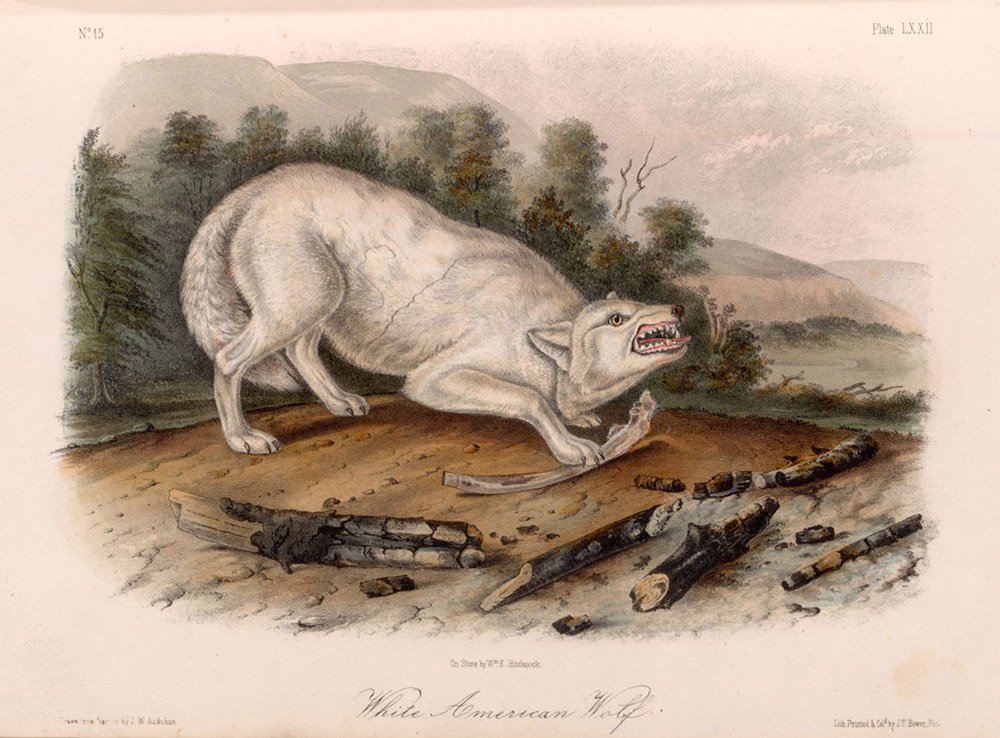
June 18th, Sunday. We now had two Antelopes and two Deer that had been killed before noon. Immediately after dinner, the head of the old male was cut off, and I went to work outlining it; first small, with the camera, and then by squares. Bell was engaged in skinning both the bodies. . . . While looking at the Deer shot this day, Harris and I thought that their tails were very long, and that the animals themselves were very much larger than those we have to the eastward; and we all concluded to have more killed, and examine and measure closely, as this one may be an exception. . . . I am told that the Rocky Mountain Rams lost most of their young during the hard frosts of the early spring; for, like those of the common sheep, the lambs are born as early as the 1st of March, and hence their comparative scarcity. Harris and Bell have shot a handsome White Wolf, a female. (See Image 6.)
June 19th , Monday. Bell cleaned the Wolf shot last night, and the two Antelopes; old Provost boiled brine, and the whole of them are now in pickle. There are some notions that two kinds of Deer are found hereabouts, one quite small [white-tailed deer], the other quite large [mule deer]; but of this I have no proof at present.
I am quite amazed at the differences of opinion respecting the shedding—or not shedding—of the horns of the Antelope; and this must be looked to with the greatest severity, for if these animals do shed their horns, they are no longer Antelopes. [Pronghorns, mistakenly called antelopes, shed the outer layer of their horns, but do not shed the entire horn as deer shed their antlers.]
June 20, Tuesday. Sprague finished the drawing of the old male Antelope, and I mine, taking besides the measurements, etc.
June 26th, Monday. This afternoon early Provost brought in a Deer of the large kind, and this also was skinned. After this Harris and Bell went off and brought in several Lazuli Finches, and a black Prairie Lark Finch of the species brought from the Columbia by Townsend and Nuttall. We caught several catfish and a very curious sturgeon, of which Sprague took an outline with the camera. . . . It had run on the shore, and was caught by one of the men. I made a bargain this morning with the hunter Bonaventure Le Brun to procure me ten Bighorns, at $10.00 apiece, or the same price for any number he may get.
June 27th, Tuesday. They saw an Antelope, some Magpies, and a Swift Fox, but no Buffaloes. . . . They ran a Long-tailed Deer, and describe its movements precisely as do Lewis and Clark.* Between every three or four short leaps came the long leap of fully twenty-five feet, if not more. The Kit or Swift Fox which they saw stood by a bunch of wormwood, and whilst looking at the hunters, was seen to brush off the flies with his paws.
July 3rd, Monday. The Bighorn hunters returned this afternoon with a Bighorn, a female, and also a female Black-tailed Deer. I paid them $15 for the two, and they are to start again to-morrow evening, or the next day.
*"The black-tailed deer never runs at full speed, but bounds with every foot from the ground at the same time, like the mule-deer." ("Lewis and Clark," ed. 1893.) [Mule deer are the same animal as the black-tailed deer, or the long-tailed deer that Audubon described. The mule deer’s bouncing way of going is called “stotting.”]
Why is this important? Audubon’s exploratory journey may seem a little tame compared to those of many other explorers, but this gentle naturalist left us excellent records of the wild animals that were present on the northern Great Plains in the 1840s. Many of these no longer live in this region or have become scarce. Audubon’s records also give us an idea about why and how some of these animals neared extinction before they were protected.


